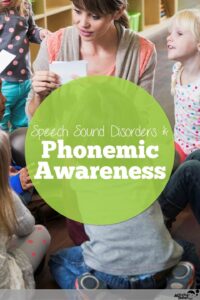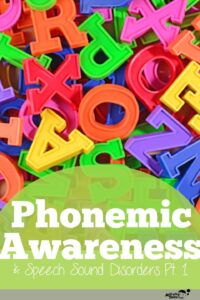Do you consider phonemic awareness abilities before beginning to work with students with speech sound disorders? If not, you really should! Read on to learn why & how you should think about and assess these skills.
What is phonemic awareness?
Phonemic awareness is the final step of a larger process called phonological awareness. It is the ability to notice, think about, and manipulate sounds within words.
Specific skills include:
- Phoneme isolation (initial, medial, and final positions)
- Blending sounds to form a syllable
- Segmenting sounds in a syllable
- Manipulating sounds (adding, deleting, substituting)
Why is it important?
According to ASHA (The American Speech-Language-Hearing Association), phonemic awareness is a vital part of developing speech production and spoken language skills. Because of this, it’s absolutely essential to monitor these skills with students who are experiencing difficulties in speech sound disorders–aka articulation and phonological processing disorders.
SLPs use auditory cues A LOT when working on speech production. Minimal and maximal pairs or auditory bombardment for correct production of articulation targets won’t get a student very far if they’re lacking in phonemic awareness skills.
If students do not notice differences in the sounds in spoken words, these cues are essentially useless for them. YIKES.
Beyond that, if you aren’t aware that a child is unable to notice these sounds or know how to change them, your frustration and patience in therapy will likely run high and thin very quickly. You may think a child is not listening or choosing not to try, when really they just need additional support in phonemic awareness skills.
Targeting phonemic awareness skills and articulation or phonological processing errors is an AND approach, not a BEFORE or INSTEAD OF approach in intervention.
Speech therapy sessions will be infinitely more meaningful and effective when a child successfully understands how to hear and change sounds within words.
So, you know WHY you need to address phonemic skills with your speech sound kiddos, but now you need to know HOW…
How to assess phonemic skills
Assessing phonemic awareness skills can feel overwhelming, especially after you’ve already spent so much time evaluating and analyzing a student’s articulation and phonological processing abilities. You’re more than ready to just jump right into treatment after those evaluations are complete!
..but by taking one more step and evaluating a child’s abilities to notice and change sounds, you will be setting up your student for more success and carryover in therapy.
Language Sample
Gathering language samples during play-based therapy are a great assessment option and always insightful to intervention. Before the session, make notes of general phonemic skills to target and pay attention to in play. Record the audio during your session so that you can go back and review to pick up on phonemic skills like rhyming or alliterations.
Assessments
If you prefer something more ready-to-use and done-for-you, The Heggerty Phonemic Awareness assessment might be what you’re looking for.
It is a great tool to make assessing phonemic skills easy and worry-free! Download assessments by grade level (Pre-K through 1st grade), in English or Spanish, or by specific phonological or phonemic skill. Literally, an SLP’s dream!
There are several other informal and formal assessments to help test phonological and phonemic skills in children. Check out these few for ideas:
- Quick Phonological Awareness Screening (QPAS)
- Phonological Awareness Test 2 (PAT-2)
- Comprehensive Test of Phonological Processing (CTOPP-2)
Next Steps
Your assessment process will guide you in determining what specific phonological and phonemic interventions best suit your individual students.
As students establish stronger phonemic awareness skills, they will be more prepared to produce more accurate speech sounds!
Check out PART 2 of this series to learn more specifics about the development of phonemic awareness skills and how to target them.
Do you need ideas for targeting phonemic awareness in therapy? Check out these interactive products in my TPT store.
You might also be interested in these other posts just for SLPs:
Teaching Attributes in Speech Therapy
Boosting Engagement…with Preschoolers!
6 Ideas for Engaging Older Speech Students








